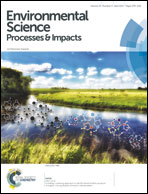Distribution, sources and ecological risk of polycyclic aromatic hydrocarbons in the estuarine–coastal sediments in the East China Sea†
Abstract
Polycyclic aromatic hydrocarbons (PAHs), total organic carbon (TOC) and black carbon (BC) in the estuarine–coastal areas of the East China Sea (ECS) were investigated. The results showed that ∑PAH concentrations ranged from 61 to 355 ng g−1 with a mean value of 146 ng g−1. The contents of TOC and BC were in the range of 1.31–7.23 mg g−1 and 0.52–5.60 mg g−1, respectively. Data analyses showed that PAH concentrations had a positive linear relationship with TOC and with BC. In addition, the grain size of silts and clays had significant influence on the PAHs of sediments. These physicochemical properties as well as coastal currents, especially the trapping effect of the Taiwan Warm Current and the Zhejiang Fujian Coastal Current, played important roles in determining the spatial distribution of PAHs in the ECS. The estimated deposition flux of PAHs was 106 t per year in the study area. Source apportionment showed that these PAHs mainly originated from oil sources, and the combustion of liquid fossils and coal/wood.



 Please wait while we load your content...
Please wait while we load your content...